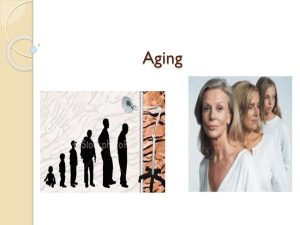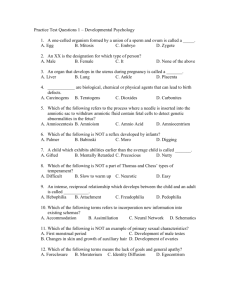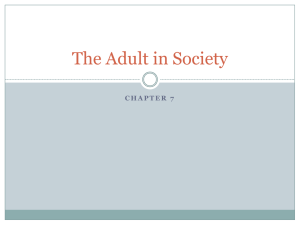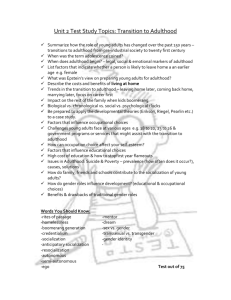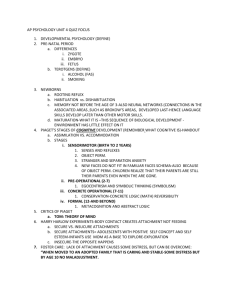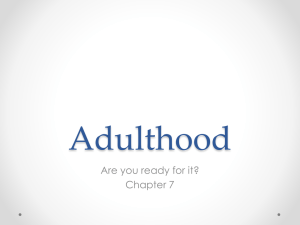CAREER DEVELOPMENT
advertisement
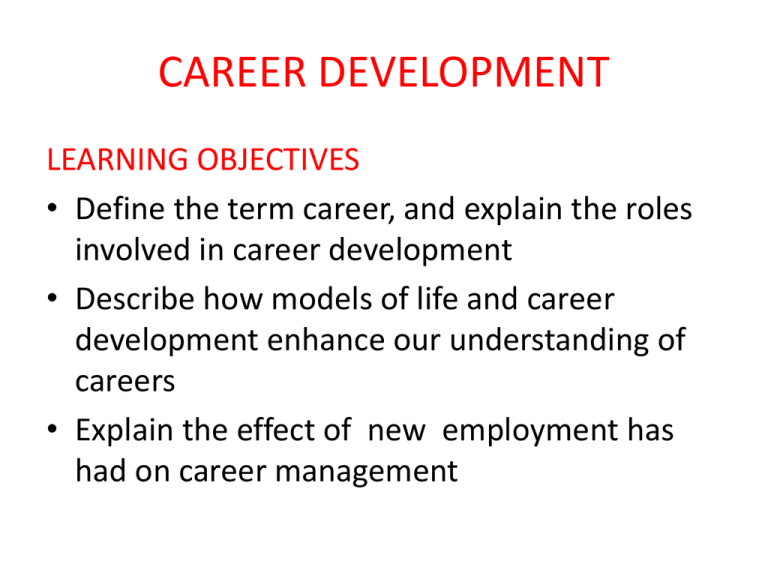
CAREER DEVELOPMENT LEARNING OBJECTIVES • Define the term career, and explain the roles involved in career development • Describe how models of life and career development enhance our understanding of careers • Explain the effect of new employment has had on career management ….objectives • Explain what is involved in career management and describe several models of career management • Describe five career management practices • Describe four issues that affect career management • Understand what is involved in designing a career management program. THE NEW EMPLOYMENT RELATIONSHIP • THE PATERNAL APPROACH. Traditionally, many employees believed that if they joined an organization, became competent, worked hard and stayed out of trouble, they would have a job for as long as they would want it. Employers offer job security and stability in exchange for loyalty. • PERMANENT WHITE WATER (Vaill 1996) characterize this unstable environment where organizations have responded to the turbulence with downsizing, shrinking hierarchies, reorganization, cost cutting, outsourcing, mergers and acquisitions, technological innovations and more performance-oriented HRM programs. Bullitin Board • • • • We can’t promise you how long we’ll be in business We can’t promise you that we won’t be acquired. We can’t promise that there’ll be room for promotion We can’t promise that your job well exist when you reach retirement age. • We can’t promise that the money will be available for your pension • We can’t expect your undying loyalty, and we aren’t even sure we want it. What is a Career? • The property of an occupation or organization – • • • describes the occupation itself (e.g. sales or accounting), or an employees tenure within an organization (e.g., my college career) Advancement - career denotes one’s progression and increasing success within the occupation or organization Status of a profession - the term is used to separate the professions such as law or engineering, from other occupations, such as plumbing, carpentry or general office work. The lawyer is said to have a career, while the carpenter does not. Involvement in one’s work. Sometimes career is used in a negative sense to describe being extremely involved in the task or job one is doing as in “Don’t make a career out of it.” • Stability of a person’s work pattern – A sequence of related jobs is said to describe a career, while a sequence of unrelated jobs does not. What is Career Development? • Career Development – an ongoing process by which individuals progress through a series of stages, each of which is characterized by a relatively unique set of issues, themes, and tasks subsumed in: Career planning and Career Management • Career planning - a deliberate process of (1) becoming aware of self, opportunities, constraints, choices, and consequences, (2) identifying career-related goals, and (3) programming work, education, and related developmental experiences to provide the direction, timing, and sequence of steps to attain a specific career goal. • Career Management – an ongoing process of preparing, implementing, and monitoring career plans undertaken by the individual alone or in concert with the organization’s career systems. STAGES OF LIFE AND CAREER DEVELOPMENT • One way to characterize person’s life or career is by identifying common experiences, challenges, or tasks most people seem to go through s their life or career progresses. • For example, Psychologists like Frued have long argued that aspects of human nature such as personality, intelligence and morality all develop in a predictable, common sequence closely tied to person’s age. • Erickson and Levinson suggest that life follows a series of common stages • Schien and Super also suggests that career s also develop in stages. STAGES OF HUMAN DEVELOPMENT • Stage Views of Adult Development by ERICKSON Basic trust vs mistrust Infancy Autonomy vs shame & doubt 1-3 Initiative vs guilt 4-5 Industry vs inferiority 6-11 Identity vs role confusion Puberty & Adolescense Intimacy vs isolation Young adulthood Generativity and stagnition Middle adulthood Ego integrity vs despair Maturity Stages of Life and Development • Levinson’ “Eras” Approach – there is underlying order to adult life called the life cycle or “eras ” are like seasons of the year in the ff ways: they are qualitatively different; change occurs within each season; there is a traditional period between each season that is part of both seasons; no season is superior or inferior to another season; each season contributes something unique to life; there are 4 seasons or eras in a person’s life: 1. 2. 3. 4. Pre Adulthood Early Adulthood Middle Adulthood Late Adulthood Levinson’s “eras” Model of Adult Development Infancy Pre Adulthood Early Adult hood Middle Adulthood 65 up 65 Late adult transition 60 Culmination of middle adulthood 55 Age 50 transition 50 Entering middle adulthood Late adulthood Late adulthood GreenHaus Five-Stage Model of Career Development – THE TRADITIONAL MODEL I. Occupational Choice: Preparation for work 2. Organizational Entry 3. Early Career : Establishment and Achievement 0-18 yrs old 18-25 yrs old 25-40 yrs old Develop occupational self image, Obtain job offers from desired org; Learn job, learn org rules and norms; assess alternative occulpation, select appropriate job based on accurate info pursue necessary education fit into chosen occupation & org increase competence; pursue THE 4. Mid career 5. Late Career 40-55 yrs old 55 - retirement Reappraise early career & early adulthood; reaffirm or modify THE DREAM; make choices appropriate to middle Remain productive in work; maintain self esteem; prepare for effective retirement CONTEMPORARY VIEWS OF CAREER DEVELOPMENT • PROTEAN CAREER – (named after the Greek god Proteus, who could change his shape at will) is based on the notion that individual drive their careers, not organization, and that individuals reinvent their careers over time as needed. • MULTIPLE CAREER CONCEPT MODEL- suggests that there are 4 different patterns of career experiences each one differs in terns of the direction and frequency of movements within and across different kinds of work overtime; 1) linear 2) expert 3)spiral 4) transitory • Linear ..continuation – a progression of movement up an organizational hierarchy to positions of greater responsibility and authority; motivated by desires for power and achievement; variable time line; the traditional view of a career in the US • Expert – a devotion to an occupation; focus on building knowledge and skill in the specialty; little upward movement in a traditional hierarchy; more from apprentice to master; motivated by desire for competence and stability; rooted in the medieval guild structure • Spiral - a life long progression of periodic (7 to 10 years) moves across related occupations, disciplines, or specialties, sufficient time to achieve a high level of competence in a given area before moving on; motives include creativity and personal growth • Transitory - a progression of frequent (3 to 5 years) moves across different or unrelated jobs or fields; untraditional; motives include variety and independence. THE PROCESS OF CAREER MANAGEMENT (An individual- oriented management model) Information , Opportunities, Support from Need to make decision Career Exploration 1 Awareness of self & environ 2 Goal Setting 3 Career Appraisal 8 Feedback: Work/non work 7 Progress 6 toward goal Strategy 5 implementation Strategy 4 development Educational, Family, Work, and Societal Institutions ORGANIZATIONAL -ORIENTED CAREER MANAGEMENT MODELS 1. THE PLURASTIC APPROACH by Brousseau et al, believes that there are at least 4 career concepts that represent patterns employees careers can take ( linear, expert, spiral, transitory) • An org career’s culture is defined by org structure, valued performance factors, and the rewards it offers employees. • Operationally, this approach offers 3 methods : (1) counseling, (2) individual career dev program contracts, (3) a cafeteria-approach that includes the variety of career tract options, training opportunities, performance evaluation schemes, and reward system • This career management approach aligns the organization and the individual careers.


